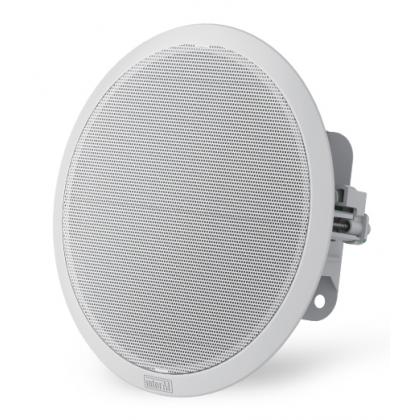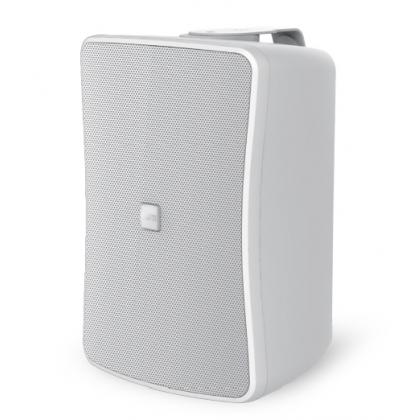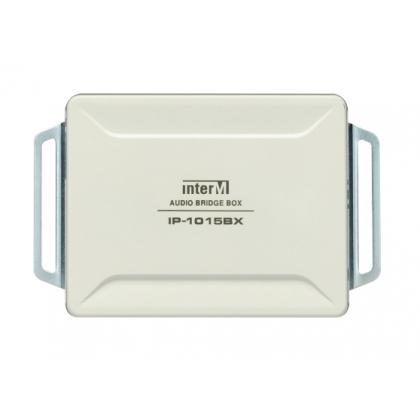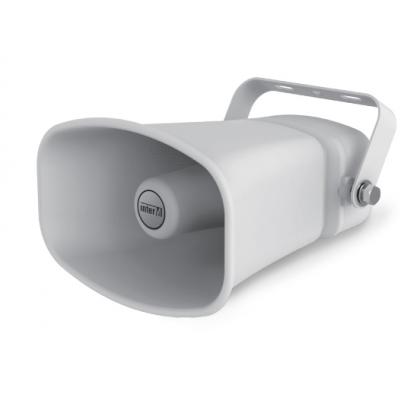Fundamentals of Public Address and Background Music Systems
CIE take a look at the many factors that can affect the audio quality we experience.

There are many factors that can affect the audio quality we experience in different environments or room spaces such as the quality of the loudspeaker and components, placement of speakers, the signal processing on the audio system. The room’s properties will also have an affect on audio quality such as absorption, diffusion and reflection.
Audio Frequency
Audible Frequencies
The human ear can identify frequencies from 20 Hz to 20 kHz; however, the upper limit of 20 kHz lowers with age. Human speech is complex and uses lots of harmonies; it is scattered over frequencies from 85 Hz for a human male and 8 kHz overtones for a human female. In telephony the range of 300 Hz to 3.4 kHz is commonly used; even though the voice is audible, the audio quality will not be as clear as a full frequency range recorded voice.
What is Sampling Frequency?
Sampling frequency is the amount of audio snapshots taken per second of analogue input audio in order to reconstruct it digitally. 44.1 kHz is a commonly used frequency in audio files and CDs, this uses 44,100 samples per second. The sampling frequency must be at least twice as high as the highest input audio frequency that should be reconstructed.
Acoustics and room dimensions
What causes echoing?
In an empty room there will be reverb and delay in sound. This is down to the flat, hard surfaces that audio waves reflect against. If uneven surfaces and soft fabrics are added into the room - such as curtains, carpets or sofas then reflection of sound (reverb) can be significantly reduced. However it is worth noting that sound levels will be lowered due to the absorption.
How can room dimensions impact on audio system performance?
The size and shape of a room has a big effect on audio experience. In a small room, audible sound waves will be reflected against walls before the waves have had chance to develop properly. Resulting in resonance and associated sound waves, this causes frequencies to be attenuated (lower sound volume) and others amplified (higher sound volume). To hear bass without any distortion you need a large room.
The impact of resonances on audio quality increases with sound volume. With higher volume the reflections will have more interference with the source sound.
In small rooms and low frequencies the room dominates the sound, in comparison to higher frequencies where the speaker dominates the sound. In small rooms the transition frequency of the room is often around 300 Hz. This frequency is where the audio can transcend from behaving like a wave to a ray.
What professional solutions are there for a neutral room acoustic?
To reduce echoes in large/empty rooms, acoustic panels can be installed e.g. on the walls and ceilings. The panels are made from sound-absorbing materials which help create a neutral acoustic in spaces such as offices, conference rooms, shopping centres and auditoriums. Similar effects can be achieved by using interior fabrics such as curtains, carpets or upholstered furniture.
Acoustic panels are effective for frequencies above 300 Hz, the absorption capabilities decrease for frequencies below this.
Measures of sound
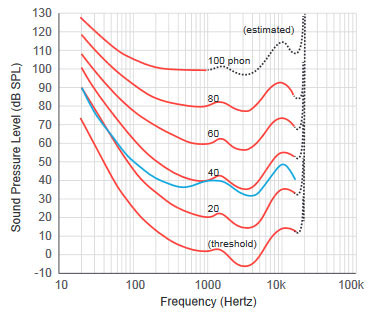 Human sound perception
Human sound perception
The human ear is sensitive to frequencies between 20 Hz and 20 kHz; however the sensitivity does vary with the frequency. Sounds use a specific power therefore may be perceived as having different loudness at different frequencies. The unit of loudness ‘phon’ takes the sensitivity into account so, for example, sinusoidal tone of 50 phons is perceived equally loud at all frequencies.
The graph shows sound pressure levels needed at different frequencies in order to make a sound perceived as equally loud over all frequencies. The curves are originally from the ISO standard ISO 226:2003.
What is ‘Watts’?
Watt (W) is a unit of power, it is found in various electrical components such as chargers, speakers and light bulbs. A watt can be used in various ways. In audio terminology you come across varieties such as instaneous power, average power, peak power and RMS.
An amplifier for example, may be constructed to deliver 300 W over a short period of time e.g. an explosion, drum or any other audio with short and loud transient will be heard. This means that the instantaneous power will increase from very low to really high quickly. The same amplifier may only be rated for 50 W continuous use; however, since the continuous use produces a lot more heat this impacts both the electrical components and amplifiers performance.
Decibels
Sound is perceived non-linearly, therefore it is best to be measured/described using the non-linear unit decibel (dB).
The decibel unit often refers to relative change in loudness. A value of 0 dB SPL is the softest sound that the human ear can perceive.

The above shows familiar sound sources and their power levels in dB.
What is SPL?
 Sound Pressure Level or SPL is the RMS value of instantaneous sound pressures measured in dB over a specific period of time. SPL isn’t a constant average value for loudness but an average of the short peak values.
Sound Pressure Level or SPL is the RMS value of instantaneous sound pressures measured in dB over a specific period of time. SPL isn’t a constant average value for loudness but an average of the short peak values.
The SPL of an audio source decreases when there is distance from the source. The SPL starts at 0 dB at 1m from the source, the SPL decreases by 6 dB with each doubling of the distance from the source.
The diagram to the right shows the sound pressure level from an audio source decreases by 6 dB with each doubling of the distance from the source
Dynamic range, compression and loudness
Compression of the dynamic range is usually applied in audio systems for retail, restaurants and public environments where they play background music at low volumes. Apart from making the volume consistent, compression also makes the quieter parts of audio more audible over ambient noise.
Speakers
Audio speakers come in different shapes depending on its purpose. The part of the speaker that distributes the audio (the speaker element) is usually cone-shaped however it can have other form factors if it should reconstruct high frequencies. Speakers can either have very narrow direction of sound in order to achieve high sound pressure and directionality or wide dispersion of sound. A speaker’s ability to reconstruct audio depends on the audio frequency.
Speaker Sensitivity
Speaker sensitivity is its ability to reproduce sound when fed a certain power. To determine the sensitivity feed of an audio signal of 1 W (typically at 1 kHz) then measure the SPL in dB at 1m distance. The common value for speakers is around 85-92 dB. The higher the sensitivity, the louder the sound from the speaker is when it is fed a certain power.
How sensitive the speaker is usually indicates the quality of the speaker. If the speaker is lower in sensitivity this indicates it has a less powerful magnet or cheaper coil. Therefore audio quality is not necessarily better in a 10 inch speaker to an 8 inch.
Choosing the right speaker
Hi-fi speakers
In hi-fi loudspeakers 2-way or 3-way speakers are common. These speakers have several different speaker elements used to accurately reproduce as much as wide a frequency as possible between 20 Hz and 20 kHz. There might be one element that is responsible for reproducing sound of up to 500 Hz, then a second one for frequencies from 500 Hz to 9 kHz, third for above 9 kHz. These are called crossover frequencies. Hi-fi speakers are designed for reproducing audio at accurate high loudness.
Horn Speakers
 The horn speaker is completely different to hi-fi speakers in comparison to its usage; the horn speaker does not cover a large frequency range. Instead the horn speaker maximises the loudness of frequencies to which the human ear is more sensitive, so the speaker can convey messages as clear as possible. The horn speaker sound is highly directional and is often used to ‘cut through’ high ambient noise levels such as factories, football stadiums, railway stations etc.
The horn speaker is completely different to hi-fi speakers in comparison to its usage; the horn speaker does not cover a large frequency range. Instead the horn speaker maximises the loudness of frequencies to which the human ear is more sensitive, so the speaker can convey messages as clear as possible. The horn speaker sound is highly directional and is often used to ‘cut through’ high ambient noise levels such as factories, football stadiums, railway stations etc.
Sound Projectors
Sound Projectors provide highly directional sound reproduction of voice and music in high ambient noise areas. They allow the sound to be pinpointed towards the area it is required, but not as harsh as a horn speaker, therefore it gives better sound quality.
Column Speakers
Column Speakers utilise multiple speaker cones to create a slim line column, this offers quality vertical sound dispersion with a long throw. However the coverage is limited horizontally. Therefore several column speakers can be mounted into a cluster, this is a regularly used solution for around pillars in church sound systems.
Column speakers are mostly used for public address in airports, lecture theatres, railway stations, churches and other houses of worship.
Ceiling Speakers
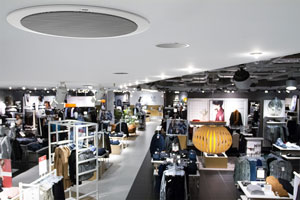 Ceiling speakers are a discreet solution for background music, public address, paging and announcements.
Ceiling speakers are a discreet solution for background music, public address, paging and announcements.
They can be used in many spaces and for different sound systems, such as paging loudspeakers for shopping centres, background music speakers for retail and restaurants to high performance Hi-Fi speakers for bars and clubs and other situations where excellent music sound quality is needed.
Ceiling speakers are usually flush mounted into ceiling tiles but surface mounted ceiling speakers can be used if a solid ceiling is present.
Pendant Speakers
Pendant speakers, otherwise known as suspended speakers are great for large buildings with high ceilings as they give a wide sound dispersion with even coverage.
They are perfect for background music sound systems for warehouses and factories. They are often also used for paging/public address systems in retail shops, garden centres and large supermarkets.
Cabinet Speakers
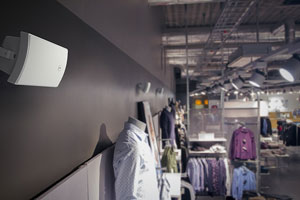 Cabinet speakers can be used for background music, public address & paging. They produce high quality music reproduction and offer extended frequency response. They are ideal for bars, restaurants & function rooms.
Cabinet speakers can be used for background music, public address & paging. They produce high quality music reproduction and offer extended frequency response. They are ideal for bars, restaurants & function rooms.
The cabinet speakers would sit around the edge of the space and project the sound into the space. It is very effective in an environment with low ambient noise level but where you need to ensure the coverage is clear.
Cabinet loudspeakers are available for both Low impedance and 100 volt line music systems.
Placement of speakers
The general rule for speaker placement is to always point the sound along the room that is if you have a rectangle shaped room. Place the speakers on the short walls and point them out along the longer walls – this will allow the sound to spread as far as possible before being reflected on the walls. It is not recommended to put a speaker in corners as this will unevenly amplify the bass sound.
The basic principles of effective surface-mount ceiling speaker installation
The first priority of a high quality sound reproduction system is that of providing listeners with an acoustic level higher than that of any possible background noise. The system must simultaneously ensure a wide frequency range and maximum intelligibility.
It should also guarantee a flat frequency response and uniform sound pressure level to give optimum listening pleasure and clarity. To meet these criteria, the hypothetical ideal solution would be to place each sound source at an equal distance from all required listening points.
Ceiling-mounted Loudspeakers
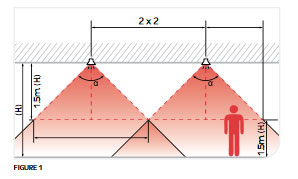 In environments with suitable ceiling heights, this ‘hypothetical’ ideal standard can be approximated by using loudspeakers with very wide frequency response and dispersion angles which remain consistent at different frequencies, arranged in a ceiling or ‘shower’-type configuration.
In environments with suitable ceiling heights, this ‘hypothetical’ ideal standard can be approximated by using loudspeakers with very wide frequency response and dispersion angles which remain consistent at different frequencies, arranged in a ceiling or ‘shower’-type configuration.
This provides the following acoustic benefits:
• Maximum sound distribution uniformity
• Maximum speech intelligibility
• Constant quality of music reproduction
• Reduced reverberation in the environment
• Sound source remains at a constant distance from the listening position
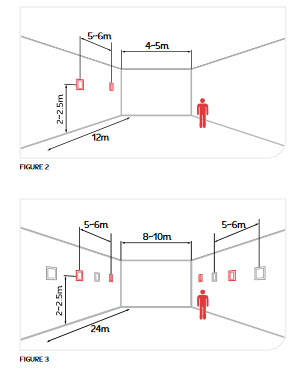 Once the required loudspeaker type has been chosen and the characteristic (ie. dispersion angle, room shape and size), the number of loudspeaker units needed to obtain constant and uniform sound dispersion can easily be calculated by dividing the floor area in square metres by the area of coverage of each loudspeaker on the listening plane. [See Figure 1 which illustrates this concept]
Once the required loudspeaker type has been chosen and the characteristic (ie. dispersion angle, room shape and size), the number of loudspeaker units needed to obtain constant and uniform sound dispersion can easily be calculated by dividing the floor area in square metres by the area of coverage of each loudspeaker on the listening plane. [See Figure 1 which illustrates this concept]
Wall-mounted Loudspeakers
If the architectural features of the room are not compatible with ceiling-mounted loudspeakers or if a wall-mounted solution is preferred, it is essential to observe a few basic rules to obtain the most effective sound distribution. In order to maintain the most efficient listening point inside the direct signal areas, both in-wall and surface mounted loudspeakers with power from 6 to 20W should be installed at a height between 2 and 2.5m.
The maximum distance between adjacent loudspeakers must be no more than 5 ~ 6 metres along the length of the room, where the room is no wider than 4 ~ 5 metres.
For wider rooms (for example 8 ~ 10 metres), it is recommended to install loudspeakers in an alternate pattern along both opposite walls, to provide adequate coverage and maintain sound pressure at the best possible constant level throughout the area for coverage.[see Figures 2 and 3]
Corridor/Tunnel: Area Coverage
 For effective sound distribution in corridors, tunnels or passenger platforms in railway underground stations, horn speakers (A) are normally specified for increased voice clarity in these high ambient noise conditions. For higher quality sound reproduction, ‘sound projectors’ can be used as an alternative.
For effective sound distribution in corridors, tunnels or passenger platforms in railway underground stations, horn speakers (A) are normally specified for increased voice clarity in these high ambient noise conditions. For higher quality sound reproduction, ‘sound projectors’ can be used as an alternative.
In all cases, these loudspeakers must be installed at a maximum distance of 15 metres from one another, mounted all in the same direction and in observance with the phase of each loudspeaker.
Alternatively, bi-directional versions (B) of these loudspeakers can be considered, positioned at a maximum of 30 metres apart (again observing phasing). [see Figure 4]
